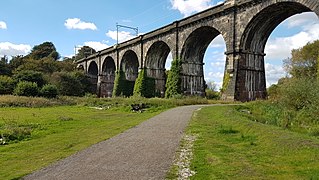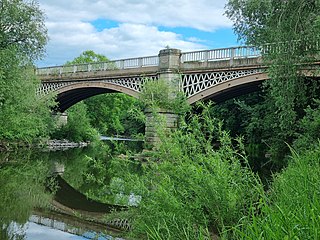
The Galton Bridge is a cast-iron bridge in Smethwick, near Birmingham, in the West Midlands of England. Opened in 1829 as a road bridge, the structure has been pedestrianised since the 1970s. It was built by Thomas Telford to carry a road across the new main line of the Birmingham Canal, which was built in a deep cutting. The bridge is 70 feet above the canal, making it reputedly the highest single-span arch bridge in the world when it was built, 26 feet wide, and 150 feet long. The iron components were fabricated at the nearby Horseley Ironworks and assembled atop the masonry abutments. The design includes decorative lamp-posts and X-shaped bracing in the spandrels.

The Huddersfield Broad Canal or Sir John Ramsden's Canal, is a wide-locked navigable canal in West Yorkshire in northern England. The waterway is 3.75 miles (6 km) long and has 9 wide locks. It follows the valley of the River Colne and connects the Calder and Hebble Navigation at Cooper Bridge junction with the Huddersfield Narrow Canal near Aspley Basin in Huddersfield.

The Sankey Viaduct is a railway viaduct in North West England. It is a designated Grade I listed building and has been described as being "the earliest major railway viaduct in the world".

A skew arch is a method of construction that enables an arch bridge to span an obstacle at some angle other than a right angle. This results in the faces of the arch not being perpendicular to its abutments and its plan view being a parallelogram, rather than the rectangle that is the plan view of a regular, or "square" arch.

Corby Bridge is a railway viaduct adjacent to and immediately east of Wetheral railway station at Wetheral, near Carlisle, in north-western England, begun in 1830 and completed in 1834. It is 920 feet (280 m) long and 100 feet (30 m) high, and has been a Grade I listed building since 1 April 1957.

Belvidere Bridge is a cast iron arch railway bridge in Shrewsbury, western England, built for the Shrewsbury and Birmingham Railway in 1849. It carries the modern Wolverhampton to Shrewsbury railway line over the River Severn and is a grade II* listed building.

The Wolverton Works canal bridge, or Bridge no. 171C, is a bridge over the Grand Union Canal in Wolverton, Milton Keynes in south-eastern England. It carries a spur from the West Coast Main Line into Wolverton Works. It was built in 1834–1835 for the London and Birmingham Railway under the supervision of Robert Stephenson and has been little modified since. It is a grade II* listed building.

The Gelt Bridge or Gelt Viaduct is a skew arch railway viaduct in the parish of Hayton, east of Carlisle in Cumbria, north west England. Built from 1832, it is one of the earliest and largest skew bridges in Britain. It is a Grade II* listed building.

Brandon Viaduct is a railway viaduct crossing the River Avon between the villages of Brandon and Wolston in Warwickshire. It carries the Birmingham Loop line and is roughly half way between Rugby and Coventry. The bridge was built in around 1835 for the London and Birmingham Railway and is now a grade II listed building.

The Sowe Viaduct is a railway bridge on the Birmingham Loop line crossing the River Sowe at the south-eastern edge of Coventry in central England. Built in 1838, it is a Grade II listed building.

The Sherbourne Viaduct is a railway bridge that carries the Birmingham Loop line across the River Sherbourne in Coventry, central England. Built in 1838, it is a grade II listed building.

Mile Lane Bridge is a road-over-rail bridge in Coventry, central England. It is possibly the first use of a flying arch over a railway cutting and is a Grade II listed building.

Wolverton Viaduct is a railway bridge carrying the West Coast Main Line over the River Great Ouse to the north of Wolverton, part of the City of Milton Keynes, in south-eastern England. Built in 1837 for the London and Birmingham Railway under the supervision of Robert Stephenson, it is one of the largest and most notable structures on the route and is a grade II listed building.

The Blisworth Arch is a railway bridge in Blisworth, Northamptonshire, in eastern England. It was designed by Robert Stephenson for the London and Birmingham Railway and completed in 1837. It is a grade II listed building and a significant local landmark.

Hampton in Arden packhorse bridge crosses the River Blythe near Hampton in Arden in the West Midlands of England, between Birmingham and Coventry. Dating from the 15th century, it is the only bridge of its kind in the area now covered by the West Midlands, and is a grade II* listed building and a scheduled monument.

The Brent Viaduct is a railway bridge carrying the West Coast Main Line over the valley of the River Brent just south of Stonebridge Park station in north-west London, England. Originally built in 1838 for the London and Birmingham Railway, it is now a Grade II listed building.

Bushey Arches Viaduct is a railway bridge on the West Coast Main Line immediately north of Bushey railway station, between Bushey and Watford, in Hertfordshire, Eastern England, just north-west of London.

The Colne Viaduct, also known as Five Arches Viaduct, carries the West Coast Main Line railway over the River Colne near Watford in Hertfordshire, Eastern England, just north-west of London. It was built in 1837 for the London and Birmingham Railway by Robert Stephenson.

Watford Tunnels are a pair of railway tunnels on the West Coast Main Line just north-west of Watford in Hertfordshire, Eastern England. The original was built in 1837 for the London and Birmingham Railway to the design of Robert Stephenson and is just over a mile long. When the line was widened in the 1870s, a second tunnel was built just to the east. Both tunnels had decorative portals and the south portal of the original tunnel is a Grade II listed building.

Abbots Langley railway bridge, also known as the bridge over Railway Terrace is a skew bridge carrying the West Coast Main Line over a road near Abbots Langley, Hertfordshire, in Eastern England. The angle of the bridge creates a 25-metre (82-foot) tunnel along the road. It was built in 1837 and is a Grade II listed building.





















